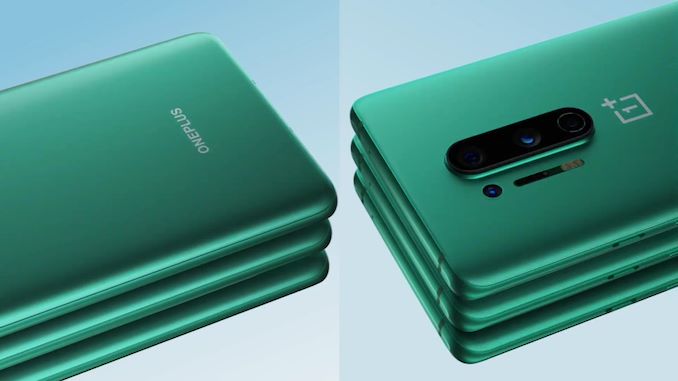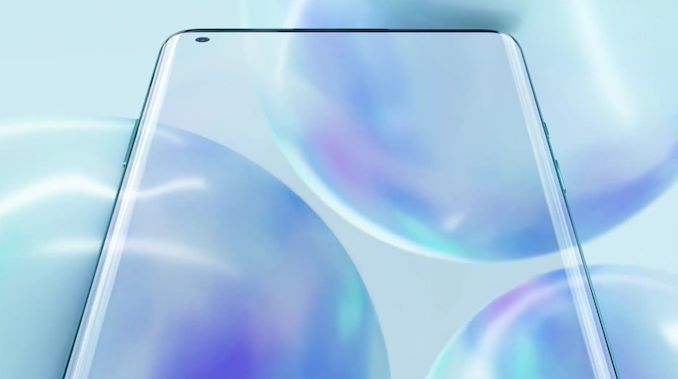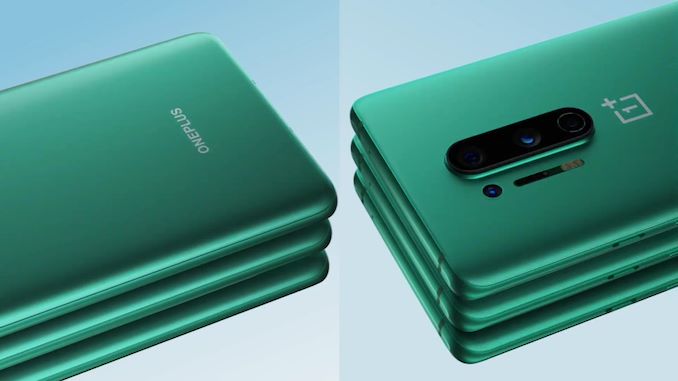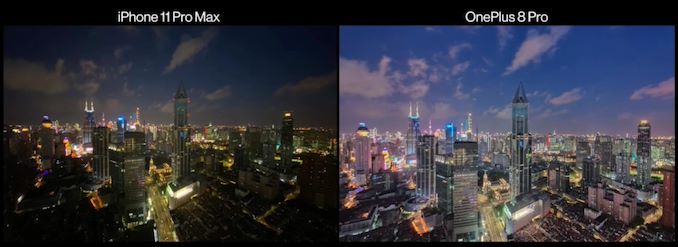OnePlus Announces OnePlus 8 & OnePlus 8 Pro: Step-Up 2020 Flagships
by Andrei Frumusanu on April 14, 2020 11:00 AM EST- Posted in
- Mobile
- Smartphones
- OnePlus
- Snapdragon 865
- OnePlus 8
- OnePlus 8 Pro

As the world is in quarantine, smartphone companies aren’t standing still and are still moving forward with their new product launches. We’ve seen almost every other company on the market release their 2020 flagships – but one important vendor has been missing from the line-up: OnePlus. Today, the company is finally revealing its newest OnePlus 8 and OnePlus 8 Pro phones, offering improvements and technology advancements at the highest levels.
Particularly the new OnePlus 8 Pro seems to be the company’s most prestigious flagship device ever, including a new QHD+ 120Hz display, a new generation 1/1.7” camera sensor from Sony along with interesting ultra-wide angle and telephoto modules, the company’s first time adoption of wireless charging – all new features on top of the existing ones that made the OnePlus 7 Pro a great phone in 2019.
| OnePlus 8 Series | ||
| OnePlus 8 | OnePlus 8 Pro | |
| SoC | Qualcomm Snapdragon 865 1x Cortex-A77 @ 2.84GHz 3x Cortex-A77 @ 2.42GHz 4x Cortex-A55 @ 1.80GHz Adreno 640 @ 587MHz |
|
| Display | 6.55-inch FHD+ 2400 x 1080 (20:9) 90Hz Refresh Rate |
6.78-inch QHD+ 3160 x 1440 (19.8:9) 120Hz Refresh Rate |
| SAMOLED HDR10+ |
||
| Dimensions | 160.2 x 72.9 x 8.0 mm 180 grams |
165.3 x 74.4 x 8.8 mm 199 grams |
| RAM | 8/12GB LPDDR4X | 8/12GB LPDDR5 |
| NAND Storage |
128/256 GB UFS 3.0 | |
| Battery | 4300mAh (16.55Wh) typ. | 4510mAh (17.36Wh) typ. |
| 30W Fast Charging | ||
| - | 30W Wireless Fast Charging (only via proprietary charger) 5W Qi Wireless Charging |
|
| Front Camera | 16MP f/2.0 |
16MP f/2.4 |
| Primary Rear Camera | 48MP 0.8µm 1/2" IMX586 (12MP 1.6µm 2x2 binning) f/1.75 w/ OIS |
48MP 1.12µm 1/1.4" IMX689 (12MP 2.24µm 2x2 binning) f/1.78 w/ OIS |
| Secondary Rear Camera |
16MP Ultra-Wide-Angle f/2.2 116° FoV |
48MP Ultra-Wide-Angle f/2.2 120° FoV |
| Tertiary Rear Camera |
2MP Macro Camera f/2.4 |
8MP Telephoto f/2.4 |
| Extra Camera |
- | 5MP Colour Sensor f/2.4 |
| 4G / 5G Modem |
Snapdragon 5G - Snapdragon Modem X55 (Discrete) (LTE Category 24/22) DL = 2500 Mbps - 7x20MHz CA, 1024-QAM UL = 316 Mbps 3x20MHz CA, 256-QAM (5G NR Sub-6) DL = 7000 Mbps UL = 3000 Mbps mmWave for OnePlus 8 (non-Pro) on Verizon in the US |
|
| SIM Size | NanoSIM + NanoSIM | |
| Wireless | 802.11a/b/g/n/ac/ax BT 5.1 LE, NFC, GPS/Glonass/Galileo/BDS |
|
| Connectivity | USB Type-C no 3.5mm jack |
|
| Special Features | On-screen fingerprint sensor, Stereo Speakers |
|
| IP68 Rating | ||
| Launch OS | Android 10 w/ Oxygen OS | |
| Launch Prices | 8+128GB: $699 / 699€ 12+256GB: $799 / 799€ |
8+128GB: $899 / 899€ 12+256GB: $999 / 999€ |
Starting off with the internal hardware, it’s a surprise to no one to see the new OnePlus 8 series being powered by Qualcomm’s Snapdragon 865 chipset. Alongside the chipset’s excellent performance and high power-efficiency is the key feature that it brings 5G cellular capabilities to both variants of the OP8, thanks to the X55 modem.
Although both variants sport the same chipset, OnePlus is amongst the first companies actually taking advantage of the Snapdragon 865’s ability to support both LPDDR4X and LPDDR5 DRAM standards – the OnePlus 8 comes with LP4X while the higher-end OnePlus 8 Pro sports the new LP5 memory. Qualcomm had divulged that they’re expecting a few percentage points performance differences between the two technologies, along with possible smaller efficiency differences. In terms of capacity, both variants come in either 8 or 12GB RAM configurations, depending on whether you chose 128 or 256GB main storage options, which by the way remains at UFS 3.0.
The designs of the phones are iterative on last year’s OnePlus 7 Pro aesthetics – with the big difference being in the front camera design choice and mechanism. The OP7Pro was notable as it was amongst one of the more popular phones out there sporting a mechanical pop-up camera housing. It was an interesting solution to get to a bezel-less in 2019, however it also came with some larger draw-backs, most notably in terms of internal hardware design complexity as well as a big increase in the device’s weight, and lack of water resistance.
The OnePlus 8 Pro makes away with the mechanical front-camera mechanism in favour of an in-screen hole cut-out, a design choice that’s been made quite popular over the last year and seemingly the “standard” for 2020 devices. Whilst I’m sure some people will be sad to see the pop-up camera go; I personally was never fan of it given the increased bulk of the phone. In the new OnePlus 8 series, the company has been able to instead increase the battery capacities, which now go up to 4510mAh on the OP8Pro and 4300mAh on the OP8, add in more camera (and bigger) sensors, and still reduce the weight of the phones by several grams, with the new OP8Pro now coming in at 199g (vs 207g for the 7Pro).
On the OnePlus 8, the company didn’t do major changes to the display characteristics compared to the intermediary generation OnePlus 7T – both phones still share an FHD+ displays with 90Hz refresh rate. On the new OnePlus 8 Pro however, the company spared no expenses as it has now opted for a 120Hz QHD+ AMOLED display. What makes this stand out compared to say Samsung’s QHD+ 120Hz S20 displays, is that OnePlus here is actually able to drive it at the full software rendering resolution. Alongside with its parent company’s Oppo Find X2 Pro, it makes the OP8Pro the only other flagship device capable of this feature.
OnePlus claims the display is capable of displaying 10-bit colour, which if true and without FRC, means that that this is the very first Android smartphone to include the feature, easily outdoing Samsung in terms of display capabilities.
If the display is even remotely comparable to the S20’s in terms of fluidity, I’m sure it will make for one of the key features of the OP8Pro. OnePlus even goes further and includes a video interpolation high-refresh rate mode that is able to convert lower fps video content to higher refresh rates – something most readers will be familiar with from their TVs. The big questions here of course is how the new phones will be able to handle the increased power consumption of the 120Hz mode, and if OnePlus one-upped Samsung in terms of effective high-refresh-rate power management.
The OnePlus 8 and OnePlus 8 Pro differ quite a lot in terms of their camera capabilities. The cheaper OnePlus 8 comes with just two “real” camera modules, a standard wide and ultra-wide, and here the hardware seemingly didn’t change all that much from the OnePlus 7 Pro. We’re still seeing the wide-spread IMX586 main sensor alongside with a 16MP unit for the ultra-wide, although with very slightly changes optics this generation, with a f/1.75 aperture lens on the main sensor, while the UWA remains at f/2.4. On top of these two primary modules, we’re seeing a 2MP macro camera. Frankly every phone I’ve encountered with such a dedicated macro module was pretty much a disappointment as the quality most of the time ends up atrocious – in essence the phone just only has 2 true rear cameras.
The OnePlus 8 Pro’s camera setup however is more impressive, and certainly more on par with what you’d expect from a 2020 flagship. OnePlus is amongst the first vendors to make use of Sony’s new IMX689 camera sensor. This unit differs from the IMX686 that we’ve seen employed in a few new phones this year in that it isn’t a 64MP sensor but rather remains at 48MP, all whilst still growing in sensor size from a 1/2” diagonal to a 1/1.4” size. This increases the pixel pitch from 0.8µm to 1.12µm – effectively increasing the pixel area by 1.92x, an almost doubling of light gathering ability of each pixel.
The new custom sensor also offers dual gain converters for dual analog native gain ISO levels – increasing low-light sensitivity all whilst retaining dynamic range in bright scenes. Much like on the newer Samsung sensors on the S20 Ultra, it comes with 2x2 OCL phase-detect pixels for focusing.
The ultra-wide-angle is also a new model. OnePlus here makes usage of a 48MP sensor, which is as far as I know the first phone with this kind of configuration. The optics include an f/2.2 aperture and the wide viewing angles measures in at 120°, a few degrees wider than the 116° of the regular OP8. Whilst the sensor should be more capable than the 16MP unit of the OP8, I have to wonder if OnePlus will limit its usage to 12MP binned pictures, as that would in effect result in lower resolution shots than the previous generation 16MP module. This all remain to be tested.
The telephoto is marketed as being an 8MP unit with f/2.4 aperture – we’re not sure if this is the same unit as on the OP7Pro, but if it is, it means that it’s actually a 13MP sensor with 2.2x optical magnification that’s cropped to 8MP and an effective 3x zoom.
Finally, there’s supposed to be a 5MP colour sensor as an extra module on the phone. Seemingly this is a module which lacks an infra-red filter and thus is able to capture a wider spectrum of colours – an effect that’s especially interesting in vegetation which appears white through IR.
OnePlus’ weakness in the camera department over the last few years has always been on the software front, with the image processing always ending up quite lacklustre compared to the competition. The OnePlus 8 Pro certainly now has the hardware to compete amongst the best 2020 flagships out there, so let’s hope the company’s software processing is also able to deliver.
Other features of the phones include stereo speakers, and an under-screen fingerprint scanner. Both phones come with up to 30W wired charging, but now OnePlus was able to finally add in wireless charging in the OnePlus 8 Pro, even doing so at 30W charging speed. It’s been a feature that was much requested over the past several years, so it’s great to finally see the company add this in.
Both phones come in three different colours each – Onyx Black in a glossy finish, Glacial Green in a matte finish, with additional exclusive colours of a glossy “Interstellar Glow” for the OnePlus 8 and a matte “Ultramarine Blue” for the OnePlus 8 Pro.
The OnePlus 8 series are available for pre-order in Europe starting right now with open sales starting April 21st, whilst in the US open sales start on April 29th. The OnePlus 8 starts at $699 for the lower 8+128GB variant and $799 for the 12+256GB version, while the OnePlus 8 Pro for the same storage options comes in at $899 and $999. Whilst certainly not the typically low OnePlus prices we’re used to from the past, if the new phones deliver on the camera quality, they still offer incredible value compared to the competition.























66 Comments
View All Comments
cha0z_ - Wednesday, April 15, 2020 - link
Apple supports their devices for 10 years and more. Recently they released security update for iphone 4s and 5 (2011 and 2012 respectably). Their full support is 5-6 years + they don't slowdown their phones anymore (4s was the famous phone in that regard where they really f it up). I have second hand iphone 6s from 2015 with changed 1y old battery - it's smooth, fast, got all the new ios features and still fully supported with every major, minor, beta release day one the same as iphone 11 pro max.It's about money. Apple profits a lot from services (app store, music, tv, arcade, storage and so on) while android mostly from sold devices. Apple got interest to support older iphones as users there spend money on apple's services, android is not like that. Samsung and the others want you to buy a new device for a premium price every 2 years and that's not acceptable. Not to mention the carriers excuse for on time updates, tell me what carrier/store will risk to not have galaxy devices for sale? Exactly, if samsung wanted updates directly by them it was easy to happen, but that again is costing them more money + they will not have the convenient excuse.
Back in the days the most expensive android devices costed half an iphone price and I was okish with the 2 years support, especially with back then fast moving technology in that sector leading to vastly better phones every year with added new meaningful features. Now it's not like that anymore and software support is more important than ever. Samsung got the balls to ask 1400 euro for s20 ultra, but in the end will abandon it after less than 2 years (I have exynos note 9, I know. It will not even receive oneUI 2.1 that released with s20 series and currently rolling out on s10 series). Not to mention that samsung sold a midrange SOC in Europe that is vastly inferior to the snapdragon variant, under the same name/model and same price (actually more here in EU).
s.yu - Wednesday, April 15, 2020 - link
IIRC Apple never slowed down their devices as long as you did swap a new and genuine battery, that made their explanation of preserving battery life of an old battery especially convincing. The throttling was not tied to device use time but to battery health.cha0z_ - Thursday, April 16, 2020 - link
Correct, but typical apple way they didn't announce it and acted as if they know better. Even throttled their phones hold, funny enough.. but it was obvious something is going on. The only real bummer was iphone 4s - there the lates ios run really bad (intentional or not, that's a totally different discussion). People still refer to that phone and blame apple how they slowdown their phones or the other case - have an bloated iphone (the same as we are used to see a lot of android users bloating their phones and blaming android for it). Actually I got iphone 6s from 2015 running ios 13.4.1 (latest) and it runs great with all the features...I still love android more tho, but ios got it's strong points too and iphones in general.
cha0z_ - Thursday, April 16, 2020 - link
Oh, forgot to add - now they give you control to that feature. It turns auto on when the battery can't provide the needed current (leading to controlled shutdown of the device, that looks sudden for the user) and limits the allowed power draw of the CPU mainly. You can turn it off in the battery menu and it will stay off till the next sudden shutdown. This is how it should be from the start.Otherwise we can see that behaviour in android as well, it's the famous "my phone shutdown suddenly when it was at 20% battery left" and similar. When the charge is lower on degraded battery, it's a lot easier to have issues with the peak current it can provide and more likely for voltage drops too. Apple's SOC normally starts with high consumption and speed when you do heavy task and thus it's easy to trigger that issue on old batteries.
tl:dr Changing the 3-4 years old battery for 50$ fixes the issue right away and as a bonus the phone battery holds up a lot more.
Toss3 - Tuesday, April 14, 2020 - link
It's 3 years now with the 8 series.Xex360 - Tuesday, April 14, 2020 - link
And they fail to impress, still highly compromised screen with the unnecessary hole, and the failure of including a headphone jack, low end in my book.s.yu - Wednesday, April 15, 2020 - link
The CEO claimed that they cater to heavy users then removed the jack. I lost all respect of them since.MrCommunistGen - Tuesday, April 14, 2020 - link
Mirroring others, I'm disappointed but not surprised that the cost went up this generation. With competitors like Samsung and Apple already charging WAY more last generation it would seem to make business sense. Also, having the external modem probably increases BOM and engineering work to some degree. Plus, if you're trying to compete with halo tier products where a higher price is associated with higher quality (whether true or not), having a higher price could help. OnePlus may be striving to compete in that space, but I'm not sure that they're there yet.For more armchair engineering:
I'm sad to see the slightly smaller aperture on the OnePlus 8 (f/1.75 vs f/1.6), but I'm really intrigued by the larger pixel size on the 8 Pro. I'm not that sad that the telephoto on the 8 is gone as these secondary and tertiary cameras often had enough other weaknesses to not be worth the trouble -- like inferior low light performance, dynamic range, etc.
I know that a hole-punch camera is the current trend for minimizing bezels, but I don't see how -- at least this implementation -- is any better than the teardrop cutout on the 7T. The hole is far enough to the left that you really can't use that top left corner for anything that would go in the notifications bar. I don't see the hole-punch as worse, I just don't see how it is better, yet I imagine that the cost of implementation is higher.
Having lived with a device lacking a headphone jack for the last 4 months, I can say that it really is a big inconvenience. I almost exclusively use my device with headphones, and having to carry around either a dongle or bluetooth headphone amp is annoying. I have good headphones and IEMs and am in the group that refuses to use inferior and more expensive "special" bluetooth headphones -- even the fully wireless type. That said, I know that the ship has sailed on headphone jacks and they're likely to never come back. I'll mourn their loss and deal with it. Calling it a "dealbreaker" on a device when virtually no other mainstream manufacturer has leaves far too few choices on the table with far too many other compromises if I get stuck on the idea of needing a new device that has a headphone jack.
As for power efficiency at high refresh rates compared to the rest of the major brands: there is at least some reason to hope that OP might perform better. This isn't their first generation high refresh device -- they've been doing this for a generation and a half already. No guarantee that they'll do it better, but they might.
I try to make my devices last at least 1-2 years, so I'm not in the market this year, but I'm still interested to see how the 8/8 Pro stack up to the rest of this year's flagships.
brucethemoose - Tuesday, April 14, 2020 - link
3.5mm loss would be tolerable if DACs were always wired to the USB-C ports, and you could stick $2 passive adapters on all your 3.5mm devices. But noooo. Expensive, bulky, fragile, sometimes incompatible active dongles are the new trend...Also, there advantages to integrating the DAC/Amp with the speaker. I got some Vanatoo
brucethemoose - Tuesday, April 14, 2020 - link
*Vanatoo monitors that have a DSP tuned for neutrality integrated into the DAC/Amp inside the speaker, and they're pretty nifty.